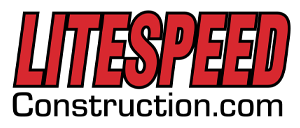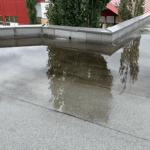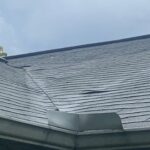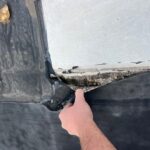Reading Your Insurance Policy: Essential Before Filing Roof Claim
When storm damage or age-related wear leads to roof issues, homeowners in Asheville, NC, and across the country may face the daunting task of filing an insurance claim. One often overlooked but critical first step is thoroughly reading your insurance policy. Without this crucial step, homeowners might find themselves underprepared or even denied coverage they believed was guaranteed. This comprehensive guide explores why reading your insurance policy before filing a roof claim can save you time, money, and frustration, along with essential insights into navigating the claims process for the best possible outcome.

Insurance Policy Basics
Every homeowner’s insurance policy is unique, often customized with additional endorsements, specific exclusions, or coverage limits. Insurance policies generally have several core sections that dictate what is and isn’t covered, especially when it comes to roof claims:
– Declarations Page: Outlines key details, including policy coverage amounts, deductibles, and the policyholder’s information.
– Coverage Sections: Typically includes dwelling coverage, personal property coverage, liability coverage, and additional living expenses. Roof claims fall under dwelling coverage.
– Exclusions and Limitations: Lists situations where coverage is limited or denied, which can significantly impact roof claim eligibility.
Insurance companies require that homeowners file claims in compliance with policy terms. Ignorance of these details can lead to costly misunderstandings when it comes to roof repairs and replacements.
Common Roof Damage Scenarios and Insurance Coverage
Understanding common types of roof damage and the associated coverage challenges can help homeowners make informed decisions before filing a claim. Here’s a breakdown of common scenarios in Asheville, NC, and nationwide:
| Type of Damage | Average Repair Cost | Typical Coverage | Policy Exclusions |
|---|---|---|---|
| Storm/Hail Damage | $5,000 - $10,000+ | Generally covered | May exclude cosmetic-only hail damage |
| Wind Damage | $4,500 - $7,500 | Often covered | Certain wind speeds may be excluded |
| Water Damage/Leaks | $500 - $3,000 | Limited | Damage from long-term leaks often not covered |
| Wear and Tear/Age | $7,000 - $12,000+ | Rarely covered | Most policies exclude gradual wear |
| Tree or Debris Impact | $6,000 - $12,000+ | Covered under certain circumstances | Damage from trees owned by homeowner or neighbors may impact coverage details |
Statistics from the National Association of Insurance Commissioners (NAIC) indicate that roof damage claims make up nearly 35% of all homeowner’s insurance claims in the U.S., with over 40% of these claims related to weather events such as wind and hail. Policies often vary in how they cover these events, making it crucial to understand the specific language of your insurance coverage.
The Role of Deductibles and Limits
A deductible is the amount the homeowner pays out of pocket before insurance kicks in. Deductibles may vary based on the cause of damage. Some policies include “windstorm deductibles,” which could be a percentage of the home’s insured value rather than a flat fee. Additionally, coverage limits may cap the reimbursement amount for roof repairs. For instance, if your policy includes a “roof depreciation” clause, reimbursement may be based on the roof’s age and condition rather than the full replacement cost. This is common in older properties across North Carolina and can mean significantly less reimbursement than anticipated.
Example Calculation:
Suppose an Asheville homeowner’s roof replacement cost is $8,000, but their policy has a $1,500 deductible and a roof depreciation clause of 25% for a 10-year-old roof. The claim payout would be approximately:
Replacement Cost - (Deductible + Depreciation) = Payout
Thus:
$8000 - ($1500 + $2000) = $4500
This homeowner would receive only $4,500, underscoring the importance of understanding your policy’s payout structure.
Policy Exclusions to Look For
Before filing a roof claim, be sure to identify potential exclusions in your policy, as they can affect your claim outcome. Common exclusions to be aware of include:
1. Cosmetic Damage Exclusions: Policies may exclude coverage for aesthetic-only issues caused by hail or debris impact, which may not affect the roof’s functionality.
2. Wear and Tear Exclusion: Most policies don’t cover damages caused by gradual wear and tear, meaning older roofs may be denied for age-related issues.
3. Pre-Existing Damage Clause: If damage was present before policy inception, it may not be covered, which is critical if a recent storm exacerbates old damage.
4. Neglect Exclusions: Policies often exclude claims if the damage resulted from the homeowner’s failure to maintain the roof properly.
The Pros and Cons of Filing a Roof Claim
Before proceeding, consider the advantages and disadvantages of filing a roof claim based on your policy’s specific details.
| Pros | Cons |
|---|---|
| Coverage for significant repair costs | Claims may increase your premium |
| Financial relief after severe weather damage | Deductibles can reduce the amount reimbursed |
| Peace of mind with professional roof assessment | Multiple claims can risk policy cancellation |
| Possible partial or full roof replacement | Some coverage may only cover depreciated value |
Filing a claim can be beneficial if the roof repair costs exceed your deductible and if the damage falls under your policy’s coverage. However, for minor damage, homeowners may consider self-funding repairs to avoid premium hikes or future claim complications.
How to Read Your Policy Effectively
To fully understand your policy, focus on these actionable steps:
1. Start with the Declarations Page: This page provides an overview of your policy limits and deductibles. Highlight your dwelling coverage limit to gauge potential roof repair reimbursements.
2. Identify Coverage Type: Most policies are either Actual Cash Value (ACV) or Replacement Cost Value (RCV). RCV provides better coverage for roof claims but often comes with a higher premium.
3. Locate and Understand Exclusions: Review the exclusion sections to be aware of any circumstances that might void your claim, such as age-related deterioration or cosmetic-only damage.
4. Review Endorsements or Additional Riders: These additions may provide extra coverage for items like windstorm or hail damage, which is particularly relevant for Asheville’s seasonal storm risks.
5. Understand the Claims Process: Some policies specify strict timelines or documentation requirements for filing a claim. Failure to comply with these could result in denial.
Case Study: Real-World Scenario of Roof Claim in Asheville, NC
Let’s consider a real-world scenario that underscores the importance of policy familiarity. After a hailstorm in Asheville, homeowner Jane filed a claim for roof damage, expecting full coverage. However, her policy had a hail exclusion that she overlooked, and the claim was denied. She ended up bearing the full $9,000 cost of replacement. This unfortunate outcome highlights the need for policy awareness and even consulting a professional roofing company or insurance advisor.
FAQs About Filing Roof Claims and Insurance Policies
Minor damage can be covered, but it’s often better to self-fund small repairs to avoid possible premium increases.
Deductibles typically range from $500 to $2,000, but some policies have percentage-based wind/hail deductibles.
Yes, filing a claim may lead to higher premiums, especially if multiple claims are filed within a short time.
Most policies exclude damage from gradual deterioration, covering only sudden, accidental damage.
Coverage varies; RCV policies may cover full replacement, while ACV policies might only cover a depreciated amount.
Check your policy’s exclusion section or speak with your insurer to verify hail coverage details.
Depreciation reduces claim payout based on the roof’s age, impacting actual reimbursement.
Yes, but insurers may recommend approved contractors. Be sure your roofer is familiar with insurance work.
You can appeal, request a re-inspection, or hire a public adjuster for support.
No, policies often have different terms for damage types like wind, hail, or water damage. Read your policy carefully.
Partnering with Professionals for Smooth Claim Processes
Homeowners should start by thoroughly reviewing their insurance policy before filing a roof claim. In Asheville, NC, where weather conditions can be unpredictable, understanding policy details becomes even more crucial. By partnering with reputable roofing companies that are familiar with the insurance claims process, homeowners can streamline repairs and avoid potential pitfalls. Before filing, consult your policy’s declarations, exclusions, and coverage limits and consider professional guidance for a stress-free experience. Proper preparation ensures that, should the need arise, filing a roof claim can be a well-informed, effective solution.





